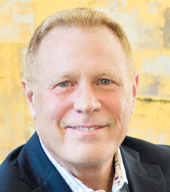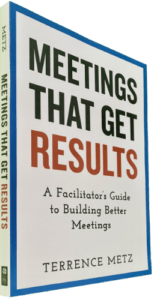One of the toughest tasks of a facilitator is to relinquish judgment and fully seek the intent behind the terms used in meetings. Therefore, facilitate meaning, not words. Structured workshops support the information revolution (as opposed to the 20th-century industrial revolution). Therefore, remind participants that their words provide instruments supporting the meaning being conveyed.

Facilitate Meaning, Not Words
The term ‘in-formation’ implies a sense of journey, rather than destination. Participants supporting in-formation technology discover that deliverables are transitory. The question is not whether a guiding principle or assumption will change, only when it changes—or perhaps more accurately, how quickly the change will occur since change is continuous. Therefore it behooves us to fully understand and facilitate the meaning behind the words being used.
FACILITATE MEANING AND INTENT, NOT WORDS
Meeting participants most frequently express and extract meaning from the world of words, which I refer to as “narrative.” Five common techniques, including narrative, express intent and meaning:
- Narrative
- Nonverbal
- Illustrative
- Iconic (symbols)
- Numeric
1. NARRATIVE
Oral and written (narrative) rhetoric relies on words, the primary means of communicating in meetings. However, non-narrative methods may be equally effective and sometimes preferred, especially when explaining complex topics and issues.
2. NONVERBAL
Substantial information during meetings transfers through body signals, openness (or closeness), shifting eyebrows, frowns of disapproval grins of approval, and the like. Hand gestures help explain the passion and intensity behind some meeting participants’ claims, along with cadence, tone, and other para-verbal traits.
3. ILLUSTRATIVE
Drawings, illustrations, and pictures reflect intent and meaning and are particularly effective in explaining complex relationships. Pictures of birds provide a much clearer understanding of birds than using words alone. Likewise, process flow and value stream diagrams may provide quick overviews more effectively and efficiently than verbal explanations.
4. ICONIC (OR SYMBOLIC)
Icons and symbols extend intent and meaning. Many icons are now universally acceptable and leapfrog the challenges associated with language challenges. Street signs, restroom symbols, and public transportation indicators do not leave much room for confusion or misunderstanding (take the stop sign, for example).
5. NUMERIC
Scorecards, spreadsheets, and other weighted ranking systems should be familiar. Additionally, I built my Quantitative TO-WS Analysis to describe the Current Situation numerically, thus avoiding some of the emotion and passion that can bog people down in searching for the right words. By using numbers instead of words, participants strive to understand in addition to trying to be understood.
OTHER TECHNIQUES
Dance, movies, music, storytelling, and other formats also communicate intent and meaning. Most of us, however, rarely employ other formats for expressing our intent when we are working with business groups.
Therefore, always be willing to challenge participants to make their thinking visible.
“Great minds like a think.”
Strive to help your speaker or participants to more fully explain the meaning behind the terms they use. Words rarely capture all of the intended meaning. However, additional challenge and facilitation improves robust understanding, making it easier to build valid and sustaining consensus.
Whether you are most familiar with the “Five Whys” or the inquisitive five-year-old, ask for proof, evidence, examples, and options to fortify participants’ thinking and their supporting arguments. Challenge adjectives and adverbs, such as ‘quick’ or ‘quality’. Ask about their meaning and intent. An excellent follow-up question is “What is the unit of measurement for insert adjective or adverb______?”
Many languages serve to build consensus, not simply English. True and valid consensus is not only an English term(s), rather it is also the meaning the participants intend to convey. The elusive nature of meaning was captured by Hafez (aka Hafiz) when he penned centuries ago:
If you think that the Truth can be known
From words,
If you think that the Sun and the Ocean
Can pass through that tiny opening called the mouth.
O someone should start laughing!
Someone should start wildly laughing—
Now!
______
Don’t ruin your career by hosting bad meetings. Sign up for a workshop or send this to someone who should. MGRUSH workshops focus on meeting design and practice. Each person practices tools, methods, and activities every day during the week. Therefore, while some call this immersion, we call it the road to building high-value facilitation skills.
Our workshops also provide a superb way to earn up to 40 SEUs from the Scrum Alliance, 40 CDUs from IIBA, 40 Continuous Learning Points (CLPs) based on Federal Acquisition Certification Continuous Professional Learning Requirements using Training and Education activities, 40 Professional Development Units (PDUs) from SAVE International, as well as 4.0 CEUs for other professions. (See workshop and Reference Manual descriptions for details.)
Want a free 10-minute break timer? Sign up for our once-monthly newsletter HERE and receive a timer along with four other of our favorite facilitation tools, free.

Terrence Metz, president of MG RUSH Facilitation Training, was just 22-years-old and working as a Sales Engineer at Honeywell when he recognized a widespread problem—most meetings were ineffective and poorly led, wasting both time and company resources. However, he also observed meetings that worked. What set them apart? A well-prepared leader who structured the session to ensure participants contributed meaningfully and achieved clear outcomes.
Throughout his career, Metz, who earned an MBA from Kellogg (Northwestern University) experienced and also trained in various facilitation techniques. In 2004, he purchased MG RUSH where he shifted his focus toward improving established meeting designs and building a curriculum that would teach others how to lead, facilitate, and structure meetings that drive results. His expertise in training world-class facilitators led to the 2020 publication of Meetings That Get Results: A Guide to Building Better Meetings, a comprehensive resource on effectively building consensus.
Grounded in the principle that “nobody is smarter than everybody,” the book details the why, what, and how of building consensus when making decisions, planning, and solving problems. Along with a Participant’s Guide and supplemental workshops, it supports learning from foundational awareness to professional certification.
Metz’s first book, Change or Die: A Business Process Improvement Manual, tackled the challenges of process optimization. His upcoming book, Catalyst: Facilitating Innovation, focuses on meetings and workshops that don’t simply end when time runs out but conclude with actionable next steps and clear assignments—ensuring progress beyond discussions and ideas.



